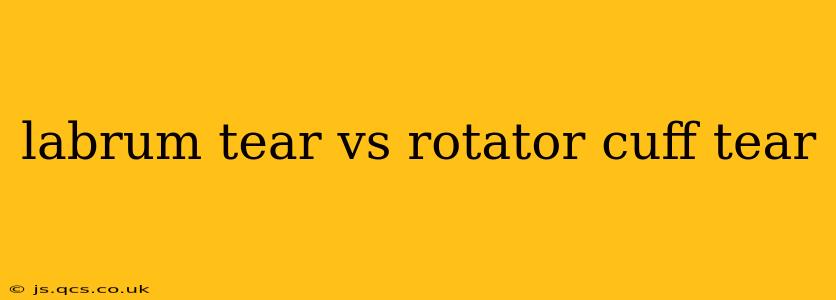Shoulder pain is a common complaint, often stemming from injuries to the complex network of muscles, tendons, and ligaments that make up the shoulder joint. Two frequently encountered injuries are labrum tears and rotator cuff tears. While both can cause significant pain and disability, they affect different structures within the shoulder and have distinct characteristics. This article will delve into the differences between labrum tears and rotator cuff tears, helping you understand the nuances of these conditions.
What is a Labrum Tear?
The labrum is a ring of cartilage that surrounds the glenoid, the socket portion of the shoulder joint. It acts as a cushion, deepening the socket and providing stability to the shoulder. A labrum tear occurs when this cartilage is damaged, often due to a sudden injury like a fall or a forceful twist, or through repetitive overuse. The tear can be partial or complete, and its location within the labrum influences symptoms.
Types of Labrum Tears:
- SLAP Tear: Superior labrum anterior to posterior (SLAP) tears are the most common type, affecting the top part of the labrum. They often involve the biceps tendon attachment.
- Bankart Lesion: This type of labrum tear typically occurs in the anterior (front) part of the labrum, often associated with shoulder dislocations.
What is a Rotator Cuff Tear?
The rotator cuff is a group of four muscles and their tendons that surround the shoulder joint, providing stability and facilitating a wide range of motion. A rotator cuff tear occurs when one or more of these tendons are damaged, often due to overuse, trauma, or age-related degeneration. Tears can range from small partial tears to full-thickness tears where the tendon is completely torn.
Common Rotator Cuff Muscles:
- Supraspinatus: Initiates shoulder abduction (lifting the arm away from the body).
- Infraspinatus: External rotation of the shoulder.
- Teres Minor: External rotation of the shoulder.
- Subscapularis: Internal rotation of the shoulder.
Labrum Tear vs. Rotator Cuff Tear: Key Differences
| Feature | Labrum Tear | Rotator Cuff Tear |
|---|---|---|
| Affected Structure | Glenoid labrum (cartilage ring) | Rotator cuff tendons (four muscles) |
| Mechanism of Injury | Sudden injury, overuse, repetitive stress | Trauma, overuse, age-related degeneration |
| Common Symptoms | Clicking, popping, instability, pain with overhead activities | Shoulder pain, weakness, limited range of motion |
| Diagnosis | Physical exam, MRI arthrogram | Physical exam, MRI, X-ray |
| Treatment | Physical therapy, surgery (in some cases) | Physical therapy, surgery (in some cases) |
What are the symptoms of a labrum tear?
Symptoms of a labrum tear can vary depending on the severity and location of the tear. Common symptoms include:
- Shoulder pain: This can range from mild to severe and may worsen with certain movements.
- Clicking or popping: A noticeable clicking or popping sensation in the shoulder joint is a common sign.
- Shoulder instability: The shoulder may feel unstable or like it might dislocate.
- Weakness: You may experience weakness in the shoulder, making it difficult to lift or rotate your arm.
- Limited range of motion: It can be painful or difficult to fully extend or rotate your shoulder.
What are the symptoms of a rotator cuff tear?
Symptoms of a rotator cuff tear also depend on the severity of the tear. Common symptoms include:
- Shoulder pain: Pain is often felt in the front, side, or back of the shoulder and may radiate down the arm.
- Weakness: Weakness in lifting or rotating the arm is a common sign.
- Limited range of motion: Pain can restrict your ability to raise your arm above your head or behind your back.
- Night pain: Pain may worsen at night, especially when sleeping on the affected side.
- Catching or grinding: You may feel a catching or grinding sensation in your shoulder.
How are labrum and rotator cuff tears diagnosed?
Diagnosis of both conditions typically involves a physical exam and imaging studies. The physician will assess your range of motion, strength, and palpate for tenderness. Imaging tests, such as MRI and MRI arthrogram (for labrum tears), and X-rays (for both conditions), are used to confirm the diagnosis and assess the extent of the damage.
How are labrum and rotator cuff tears treated?
Treatment options for both labrum and rotator cuff tears depend on the severity of the injury and individual factors. Conservative treatment options, such as rest, ice, physical therapy, and medication, are often the first line of defense. Surgery may be considered for more severe tears that don't respond to conservative treatment.
Can you have both a labrum tear and a rotator cuff tear at the same time?
Yes, it's possible to have both a labrum tear and a rotator cuff tear simultaneously. These injuries often occur together, especially after a significant traumatic event. The overlapping symptoms can make diagnosis more challenging, highlighting the need for a comprehensive medical evaluation.
This information is for general knowledge and does not constitute medical advice. Always consult with a healthcare professional for diagnosis and treatment of shoulder pain.
